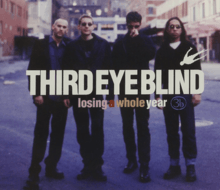Losing a Whole Year
"Losing a Whole Year" is a song by American alternative group Third Eye Blind. It was released in March 1998 as the fourth single from their 1997 self-titled debut album. It was written by Stephan Jenkins and Kevin Cadogan. The song received positive reviews from music critics and charted on the Billboard Alternative Songs and Mainstream Rock charts. A music video was released in support of the single.
| "Losing a Whole Year" | ||||
|---|---|---|---|---|
 | ||||
| Single by Third Eye Blind | ||||
| from the album Third Eye Blind | ||||
| Released | March 1998 | |||
| Format | CD | |||
| Recorded | 1996 | |||
| Studio |
| |||
| Genre | Alternative rock | |||
| Length | 3:20 | |||
| Label | Elektra | |||
| Songwriter(s) | ||||
| Producer(s) |
| |||
| Third Eye Blind singles chronology | ||||
| ||||
| Music video | ||||
| "Losing a Whole Year" on YouTube | ||||
Background
The song was written by Stephen Jenkins and Kevin Cadogan.[1] According to Jenkins, the song "started from a riff that Kevin was playing on the guitar. The words were how that riff made me feel. The story is just lamenting the end of a relationship and all of its wasted time." During a concert on December 9, 2000, Jenkins said that the song "is about a rich girl from Bernal Heights."[2]
Composition
According to the sheet music published at Musicnotes.com by Alfred Publishing, the song is written in the key of E major and is set in time signature of common time with a tempo of 108 beats per minute.[3] Jenkin's vocal range spans one octave, from F#4 to A5.[3]
Reception
Critical reception
"Losing a Whole Year" was released as a single from Third Eye Blind's 1997 self-titled album.[4] The song received a positive reaction from music critics. Chuck Eddy of Spin magazine called it one of the band's "catchiest" songs.[5] Allmusic's Mike DeGagne agreed, writing that "its pop-friendly makeup of frolicking guitar and a welcoming tempo make it one of the band's most catchiest tunes."[6]
Music video
Third Eye Blind planned to make two music videos for "Losing a Whole Year", but ultimately only one was released.[8] The video features the band performing the song in front of an audience of three laughing women. At the end of the video, two cars crash into each other right in front of the band members.
Formats and track listings
| No. | Title | Length |
|---|---|---|
| 1. | "Losing a Whole Year (Remix - Strings Up)" | 2:59 |
| 2. | "Losing a Whole Year (Radio Mix)" | 3:18 |
| 3. | "Losing a Whole Year (Remix)" | 3:12 |
| Total length: | 09:29 | |
| No. | Title | Length |
|---|---|---|
| 1. | "Losing a Whole Year" | 3:21 |
| 2. | "Horror Show" | 4:02 |
| Total length: | 07:23 | |
| No. | Title | Length |
|---|---|---|
| 1. | "Losing a Whole Year" | 3:21 |
| 2. | "Horror Show" | 4:02 |
| 3. | "Graduate (Remix)" | 3:26 |
| Total length: | 10:49 | |
Charts
| Chart | Peak position |
|---|---|
| U.S. Billboard Modern Rock Tracks[1] | 13 |
| U.S. Billboard Mainstream Rock Tracks[7] | 36 |
Personnel
- Stephan Jenkins–lead vocals, percussion
- Kevin Cadogan–lead guitar, backing vocals
- Arion Salazar–bass guitar
Additional musicians
- Michael Urbano–drums
Covers
- In 2009, American post-hardcore band A Lot Like Birds, on their album Plan B, included a cover of "Losing A Whole Year" at the end of their song "Sesame Street is No Place for Vengeance" as a hidden track.
References
- "Losing a Whole Year - Third Eye Blind". billboard.com. Retrieved March 19, 2011.
- "Losing a Whole Year". stephanjenkins.com. Retrieved October 17, 2010.
- Third Eye Blind (1997). "Third Eye Blind 'Losing a Whole Year' Digital Sheet Music". Musicnotes.com. Retrieved June 23, 2020.
- Tirone, Mike. "San Fran Band, Third Eye Blind to perform at Loyola" Archived 2011-07-13 at the Wayback Machine. loyolagreyhound.com. January 21, 2008. Retrieved March 19, 2011.
- Eddy, Chuck. "Third Eye Blind / Smash Mouth". Spin. May 1998, p. 142.
- DeGagne, Mike. "Losing a Whole Year". allmusic.com. Retrieved March 19, 2011.
- "Third Eye Blind". allmusic.com. Retrieved March 19, 2011.
- "Third Eye Blind Really Wants To Direct". mtv.com. April 13, 1998. Retrieved March 19, 2011.